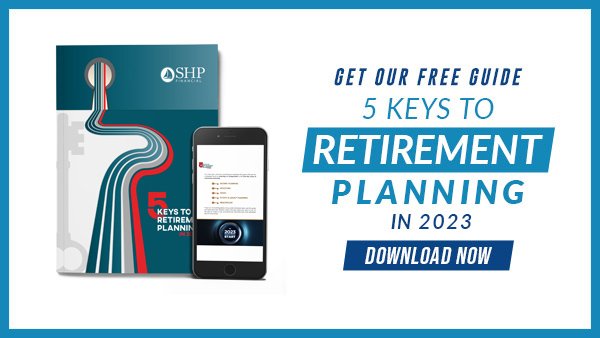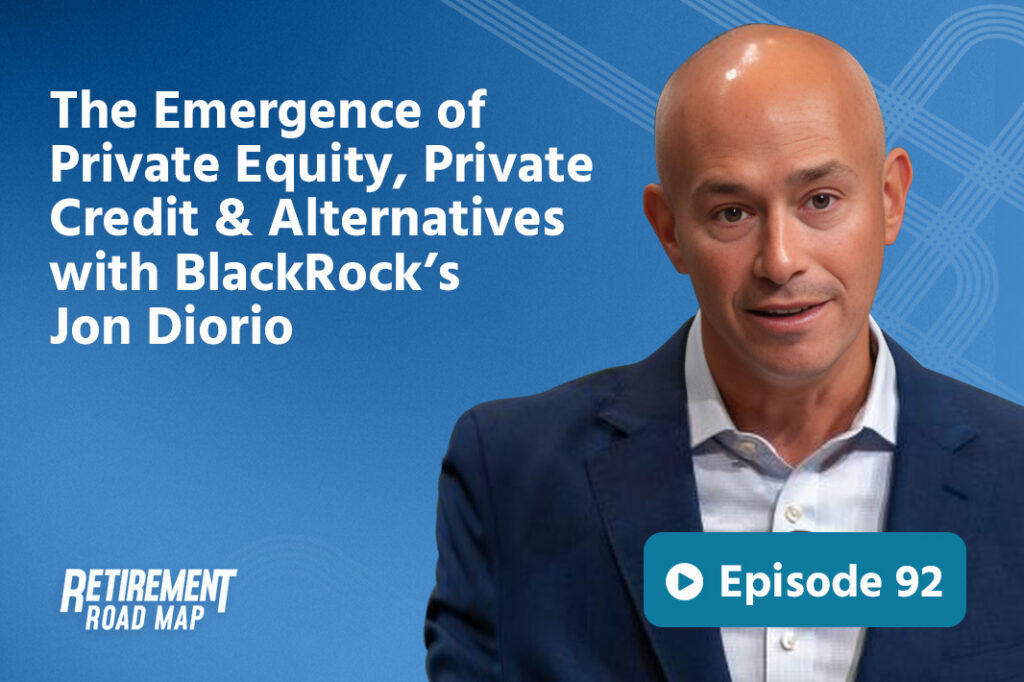Whether we like it or not, our tax laws will be changing again soon. That’s why it’s so important to keep your tax planning needs top of mind and be aware of what those changes are and how they factor into your retirement plan.
Today, we’re once again joined by Chase Reardon to talk about some important changes to the Tax Cuts and Jobs Act and how you can take advantage of opportunities that exist to mitigate taxes.
We’ll discuss why tax planning and portfolio planning have to go hand in hand, how Chase and the SHP Financial team works with clients to build a tax plan for their specific needs, and what you can do right now to save money in retirement.
In this podcast discussion, you’ll learn:
- Why tax planning can never be a set it and forget it strategy.
- The major advantages of the Tax Cuts and Jobs Act–and why these benefits will mostly go away at the end of 2025.
- How to know whether a Roth conversion is right for you.
- Assets you can use to change your tax structure, including trusts, charitable gifts, and 529 accounts.
Inspiring Quotes
- “Don’t just do a Roth conversion. There has to be a strategy around it.” – Chase Reardon
Resources
- Chase Reardon on LinkedIn
- Nicholas Nelson
- SHP 049: An Inside Look at the SHP Solutions Teams with Nick Nelson
- SHPQuiz.com
- Maura Healey
Matthew Peck: Welcome everyone to another edition of SHP Financial’s Retirement Road Map podcast. I’m your host today, Matthew Peck, joined by co-host Derek Gregoire. And today, we are going to be talking about the tax cuts. Very often, whether it’s our television programs or even the podcast or during our meetings or whatever that may be, we’re always talking about how the taxes are on sale and how, okay, you should be taking a look at your tax planning now because in a couple of years, those taxes are going to be obsolete. The changes are coming. So, what are those exact changes? You might be wondering. And that’s what we’re going to be talking about today.
So, we’re joined today also by Chase Reardon. He joined us about four to five years ago, has been helping out families plan their financial future since that time. So, we’re very happy to have him come on. He’s actually a recurring guest, which we’ll give him a little bit of hard time about. But before we really kick into taxes, Derek, Chase, how are you boys doing?
Derek Gregoire: Doing well. No complaints. Just excited to dive into the tax language. It’s what I strive to do every day. Just learn about these tax codes. Now, but in all seriousness, it’s kind of one of the things you, Matt, and Nick had a great podcast a few weeks ago.
Matthew Peck: Thank you.
Derek Gregoire: I think it’s just important to know and I’m also sometimes reminded to our staff and our clients and folks that are looking to join SHP, the reason why we’re very careful in terms of making sure it’s a good fit with who we work with is the amount of planning that goes into what we do and all the different teams in the background here at SHP. I thought that was such a great, podcast. I forget the exact number it was, but if you go to our podcast, you can find it, it’s with Nick Nelson and Matt Peck.
And long story short, it shows like a lot of other firms, you go and sit down and you go through a portfolio, and that’s your entire plan. For here, we have almost 50 employees doing a full-time job of the planning, the research. We work with CPAs and tax professionals and estate planning attorneys. And so, there’s so much, Matt, you said it great a few weeks ago. It’s like– I forget how you word it, but it’s like you just set it and forget it. And that’s the end of it. It needs like, you don’t just take care of your lawn one time and get it treated, and then it’s green the rest of your life. There’s a lot of maintenance that goes into building a plan, but then keeping that plan maintained.
And part of our job for our clients, what we have Chase on for today, is making sure we’re staying ahead of the curve. And so, if we know there are certain laws literally changing, in terms of taxes, and we say taxes are on sale, then it’s our job as planners to let our clients know, okay, here’s an opportunity because if we know tax rates are going to be higher and we can do some tax planning at today’s rates, that literally saves you dollars in your retirement.
Matthew Peck: Well, and that’s at the part two. I just go back to the sort of research and the amount of work that we go into it or that goes into it and how much focus that we have on it because, Derek, I neglected to mention that Chase himself is a CTS or a certified tax specialist. So, let’s go ahead and let’s dive in now. Chase, hey, welcome to the podcast.
Chase Reardon: Thank you very much. Welcome back.
Matthew Peck: Welcome back. Yeah, great point. So, now, all right, first, even before we get into the tax cuts back in 2017 and where they’re going and what’s happening, yes, tell us about yourself. Tell us about the whole CTS and kind of why taxes are so important to you when it comes to financial planning.
Chase Reardon: Yeah, it’s a great stuff, Matt. Yeah, so I’m a certified tax specialist. And it’s really over the last, like what Matt was saying, three to four years, I think taxes are really an underserved area in a lot of people’s financial plans. And I know Derek just talked a little bit more in depth about it. But I think taxes are interesting because they’re oftentimes overlooked. And with that being said is when we’re looking at these plans and we’re saying, okay, well, yeah, the portfolio is great or the portfolio is constructed well, but it’s like, what’s the tax implications of some certain investments or providing income to the folks that we work with? I mean, oftentimes when we’re sitting down with folks, we’re often saying, how do taxes affect you, is the first step, and then how can we help mitigate taxes in the future? I think that’s an extremely important point because, again, a lot of the folks that I sit down with, they don’t even know how their Social Security is taxed or their IRAs, pulling income out of their IRAs, what’s the tax liability there? And I think the first step is finding out how taxes affect you and then how you mitigate them.
Derek Gregoire: Yeah, if you said, Chase, looking at like an IRA, most of the folks listening, I bet the biggest part of their assets might be IRAs, 401(k)s, 403(b)s. And I always say the easiest way to look at taxes is let’s say down the road, you’re going to retire and you need 50,000, puts it in an IRA, we might need to take out 80, then pay Uncle Sam his portion, the state, their portion, and then you keep 50, but that’s 80 coming out of your portfolio. If it was in a tax-free bucket and there’s different ways to maybe get, it sometimes does make sense, sometimes doesn’t make sense, but if we can get it in a tax-free bucket when you need 50, guess what comes out of your portfolio? Just 50. We don’t think the taxes are already paid. So, let’s start into like, I know the tax, the TCJA, what does that mean? What does it stand for?
Chase Reardon: So, yeah, the Tax Cuts and Jobs Act, it was signed into law in 2017. It took effect January 1st, 2018. And it was a really one of the biggest tax reform bills that they’ve passed in many, many years. And really, what it did was is, at a high level, it cut corporate tax rates. It also cut individual tax rates, which I think is really where it pertains more towards retirees, and people in the financial planning world was the cut of the individual income tax rates, as well as the increase in the standard deduction that folks get now.
And I think those are two kind of extremely important things, and this bill will expire at the end of 2025. And I think that’s really why we’re having this podcast is because the time window to take advantage of some of the rules in the Tax Cuts and Jobs Act will end at the end of next year. We encourage folks to come in. We’ll sit down with their 1040s and review all their sources of income and begin to develop a plan of, again, how taxes affect you and then how we can mitigate them.
Matthew Peck: And how do you start then? Do you then sit down with somebody? Is it taking a look at their 1040s? Is it just more of an asset review, and then you’re asking and you’re digging into the source of that asset? I guess, how do people know what their tax liability is?
Chase Reardon: It’s a great point, Matt. And yeah, I think it’s dual wielded. It’s the 1040 and it’s the assets, right? Because I mean, what happens is, like, people are on fixed income, Social Security’s or pensions. But then it’s like, they’re going to oftentimes need income in addition to those sources from the portfolio. So, it’s like, figure out the base income, where your base income is and how that’s taxed. And then, it’s like, okay, let’s look at the different buckets within the portfolio and how they’re taxed and how we can mitigate taxes on that end.
Derek Gregoire: There’s so many different strategies around tax planning because like we looked at and I know Chase made some great notes, like you have Roth conversions. That’s one strategy which can be good for some, not good for others. There’s tax loss harvesting on after-tax accounts. You have the addition, the federal estate tax in Massachusetts. If you live in Massachusetts and you’re listening, every state is different. But once you get over $2 million, there’s a state tax at death that you can sometimes mitigate and reduce or eliminate with proper planning ahead of time, especially if you’re married.
And then on top of that is a federal estate tax, which everyone says, oh, I’m never going to get to that because it’s like 13 million. Well, guess what? That’s going down as well in the next few years. So, if people think tax planning, it’s not just, oh put money in a 401(k) and save on taxes. There’s so many different elements at play here. But like, we talked about, Chase, let’s start with just income tax rates. That’s one of the most known, you make money whether you’re working or retired and you’re in a certain bracket. You can explain where brackets are now and where they’re going. It’d be a good starting point.
Chase Reardon: Yeah. So, I think it’s important just to kind of reiterate that we operate on a marginal system here in the United States in terms of taxes. So, the more you make, the more you will get taxed. And it’s an increasing amount in each bracket. So, the lowest bracket, you’re taxed at, we’ll call it 10%. And then the more you make, it goes up from there. So, what happens is right now, since 2018, the marginal rates have actually roughly been reduced by 2% to 3% across the board, minus the lowest marginal income tax rate.
And what happens is, like Derek was saying, at the end of 2025, these rates actually revert back to their older and higher rates. So, as an example, if you’re in the 22% marginal tax bracket, well, at the end of 2025, that actually is going to increase to 25%. And I choose that number because a lot of the folks that we work with that are married, filing jointly, do lie within the 22% to 24%. So, I think that’s extremely important to kind of know that, if you’re in the 22% and Matt, going back to the base income thing, if you’re base income plus some IRA distributions keeps you in that window, well, it’s like that same bracket is going to 25%. And actually, the brackets below it are going higher as well. So, you need to be really cognizant of how this can affect your plan.
Matthew Peck: Well, and let me kind of back up a little bit, just so all of our listeners understand, when we mentioned terms like marginal and even tax brackets, that’s why I like to rather than using the term marginal or even brackets, let’s talk in terms of buckets, right? Rather than brackets, think in terms of buckets. So, everyone, when you first earn, let’s say, first $30,000, that gets taxed at 10%. Your bucket gets filled and then it pours into bucket number two.
So, now, the bucket, like the second bucket starts to that next amount of earnings as we’re talking about base income, now, that gets taxed at 12%. All right, that bucket gets filled or bracket. Okay, now, then it pours into the next bracket and then let’s say 22%. And then marginal, when we say marginal rate, it’s just an average, correct, of all of these like 10% on this chunk, 12% on that chunk in 22. Is that how it works?
Chase Reardon: Well, so I think you might be referencing the effective tax rate. Yeah, so that’s a good point, Matt. It’s like, okay, yeah. It’s like you go to file your taxes and your account might say, okay, you’re at the 20% tax rate. Well, oftentimes, they use the effective rate.
Matthew Peck: That’s a combination.
Chase Reardon: Right. That’s a combination across all the marginal brackets or the buckets as Matt’s referencing, which is great. But the effective tax rate is oftentimes, okay, well, when we’re doing some of this more in-depth tax planning, we need to look at the marginal rate and say, “Okay, where’s your income in these different buckets? And where can we do some of this tax planning?” And I think that’s an important thing to look at.
Derek Gregoire: Well, think of it. If you’re listening or watching, you have these brackets that a lot of our clients end up in that 22% or 24% bracket when they retire. When they’re working, sometimes they’re over that. But when they retire, once you get over like 80,000 and the standard deductions and all that, in that $80,000 ballpark, it goes up to 22, and then it stays to 22 all the way to like 170, 180, somewhere in that range, then goes to 24. And from that range, it goes all the way to 300 something thousand before it changes again. So, 22, 24 is not a huge jump.
So, think about it, if let’s say your Social Security and your investment income and some rents and part-time work is 100,000, right? And let’s say you have that coming in. Well, when you hit retirement required minimum distribution age, which for most people right now at 73, it could be higher depending on your age right now, but when you hit that age, you’re required to take money out of your IRA and 401(k). So, if you’re already at $80,000, $90,000, $100,000, guess what? The additional withdrawals is all going to be taxed at that higher rate or the top rate, which in that case is 22%.
And if we know 22% as of right now based on current law is going to 25%, then would it make sense to pay 22% now as opposed to paying 25% or maybe more down the road? And obviously, when you look at our national debt, we don’t have to go down this whole tax road, but most people think taxes are going higher. It’s slated to go higher per our law right now. And so, with our clients, we always want to look at their situation and say, okay, the market and all that is everyone’s best guess. We do a good job building portfolios, rebalancing, but it goes up and down. The tax law, we know exactly where it is now and we have an idea of where it’s going. So, those are known knowns that we can take advantage of within planning.
So, I think, with that being said, some of the strategies that we look at and I’ll just mention here, Chase, you have Roth conversions, don’t just go to a Roth conversion because it has to be done professionally within brackets. There has to be a strategy around it. So, Roth conversions are one strategy. You can contribute more to Roth 401(k) and after-tax accounts. You can take distributions from IRAs now to fund your income and let other tax-free buckets defer. There’s all different strategies. Each one’s unique to you.
So, getting income is one part of the plan when you retire because when you retire, you’re unemployed, but how that income comes out in the tax liability and the strategy of what to draw from first, what to defer till later is so, so important. And at the end of the day, if you look at, right, before we get into the next subject here, Chase, we have these three kind of chunks of money. We’ll go back to the buckets, Matt, is yeah, there’s your pretax bucket which most people have like 80%, 90% of their money there. That’s money that’s never been taxed because you deferred money in your 401(k), IRA, 403(b) and you got a little deduction over the years. But now, the entire pot of money is a ticking tax time bomb. Every dollar you pull out is taxable. So, that’s like a pretax bucket.
Your after-tax bucket, it’s like your savings, checking, brokerage accounts. You’ve already paid taxes on that money, but it’s not the best because anytime you earn interest, CDs, whatever, brokerage capital gains, it’s taxed as you earn money on that bucket. It’s still better than pretax. The third bucket is tax free. Ideally, that’s where you want all your money going. So, when we’re doing planning, if you look at the two not-so-good buckets of pretax and after-tax and you look at the top bucket of being the end-all, be-all, best place to be, we’re trying to flow as much money from the pretax bucket through conversions, if possible, up to tax free and after-tax bucket through contributions. Whether it’s 401(k), IRAs, we’re trying to get those up to tax free into Roth buckets.
And so, the idea is just– and I’ll stop on this little soapbox here, but just like you want to diversify in your 401(k), in your retirement plans, in your investments, it’s so important to have tax diversification because in the future, then you can maybe play a game a little bit and say, “Okay, maybe I’ll take this much out of my IRA to get to this bracket, but the rest, I’ll take from my Roth that won’t drive me into the next bracket.” And you can actually have more flexibility, whereas if everything is in IRA and you don’t do any planning, well, guess what? You’re up to whatever the government says you have to pay.
Matthew Peck: Well, and I think, too, I think– and sorry to interrupt, Chase, I mean, that’s why sometimes, it’s frustrating or I think that illustrates a great point of the difference between tax planning and tax preparing. Because sometimes, I think some of our listeners, they’ll go online, they’ll say, “Okay, what bucket should I draw from first? Or should I take it from my after-tax account and should I take from my IRA and whatnot?” And I still think there’s sort of, I don’t know, I mean, just the current conception or the current idea is, oh, I’m going to continue to defer my IRA money as long as I can because I want to earn interest on interest. And then they’ll have CPAs in their ears saying, “No, no, no, don’t pay more taxes now. Just defer it, defer it, defer it.” And yeah, that makes sense on paper.
But then when you look at these tax brackets, that kind of flies in the face of it, like, no, no, don’t defer some of these IRA distributions now because, as you were saying earlier Derek, it’s like, okay, we’re going to tax on– what would you rather do, pay tax on 22% of that chunk or 25%? 24% to 28%? I mean, just the fact that that’s still out there blows my mind and that’s why CTS’s and good financial planners will say, “No, no, no, you have to rethink that.”
Derek Gregoire: Well, some people will say, “Well, if I paid taxes now, I’m not compounding my money.” And my response is, if you defer it and wait, guess what? The IRS’s, you’re also compounding their money. Because if you have $1 million and you owe them 20%, that’s 200,000. If you have $2 million because you’ve compounded it and you own 20%, that’s 400. So, you’re not getting away from, if you’re growing their pile as you go, I’d rather have that growth in a tax-free bucket where Uncle Sam is not involved, the state is not involved as much to the same degree.
So, long story short, there’s planning opportunities that exist. Take advantage of it. One of the things I’ll say, an easy way, if you’re listening and you’re like, “I’m not sure where I stand on the tax side,” we have a simple quiz on our website. It’s SHPQuiz.com. You’ll type in a few answers to a few questions to your situation, and it’ll kind of give you a basic report that does need some more detail and information on, but I’ll give you a starting point to see if this is a weak area within your financial plan, so SHPQuiz.com. All right, Chase…
Chase Reardon: Derek, I just want to say one more thing too. It’s like, oftentimes, the Roth conversion process can be a little scary. And oftentimes, folks will say, “Oh, well, I’m not going to be able to convert this million-dollar 401(k).” And converting the whole million-dollar 401(k) is usually not the idea, right? It’s doing it in a comfortable and confident process and entails us in our team kind of looking at the numbers and not kind of looking at the numbers and saying, “Okay, well, here’s where you stand and here’s two or three scenarios of what a Roth conversion might look like for your situation.” And I think that’s important because some folks won’t convert a whole lot one year, but the next year, they might convert a little bit more. It all depends on their income and what they’re comfortable doing after our job to provide them with some of the more detailed numbers on, hey, this is how this might look now, but how it might look long term within your portfolio.
Matthew Peck: Well, let me know– absolutely, Chase. And so, let me also talk two things, (a) I always get a kick out of how little that’s known out there. I mean, I have very, very smart people out there and they have questions on things like RMDs. And we do RMDs every day and we’re like, “What do you mean?” It’s this, it’s that. But we do that every single day. So, there’s a lot of misconceptions out there, and we certainly want to make this as informative as possible. So, Chase, walk us through the standard deduction. How does that work? I think there’s a lot of questions about that as well.
Chase Reardon: Yeah, that’s a good point. Yeah. So, what happened, sort of related to the Tax Cuts and Jobs Act first, is before the standard deduction, folks were allowed to take what’s called a personal exemption. And not to get too technical, but really, the personal exemption was a smaller standard deduction. And what happened was with the Tax Cuts and Jobs Act, when it passed in January 1st, 2018, there was a standard deduction implemented across the board in the tax code. And what that allowed people to do was take a higher personal exemption, now called the standard deduction, instead of itemizing their taxes.
And I think it’s a common misconception where people are saying, oh, well, I can deduct my mortgage interest or I’m deducting real estate taxes. Oftentimes, folks are taking the standard deduction. I think Forbes came out with a statistic where it’s like 90% of people take the standard deduction, which directly reduces your tax liability that you owe at the end of the year. So, I think it’s important to say, “Okay, well, at the end of the Tax Cuts and Jobs Act, that standard deduction actually goes away and they’re going back to a personal exemption code, where it’s going to be a lot less than the current standard deduction,” which I think is important because, one, we have higher taxes on the horizon, but, two, we also have a standard deduction that’s being reduced at the end of 2025, which can entail more taxes, potentially.
Derek Gregoire: Yeah. Just to make sure it’s clear too, a standard deduction, if your income is 130,000 instead of, back in the day, we get all of our tax statements and mortgage and interest and you try to see how much can I deduct. And sometimes, it still makes sense to itemize. But for most folks, just taking the standard deduction is more than they could have taken had they itemized. So, you make 130. Now, you just make 101. And that 29,000 is for married, filing jointly, as you mentioned. But if you’re single, it’s half of that rate, about 14,500. But that comes right off of your taxable income and you’re paying taxes on that less amount of money. So, you have a couple of things happening. Taxes look like they’re going up. Standard deduction looks like it’s going to change. And a lot of people, like I said, they think, well, I’m still saving on my home equity line interest there.
Matthew Peck: Absolutely. I get that question still.
Derek Gregoire: Yeah. And that looks like, again, that’s another change that could be coming around the horizon. And to be truthful, Congress could vote and make changes sooner than this. It could be worse than this. It could be– we don’t know exactly where it’s going to lie. We just know, as it stands right now, everything is changing too if there’s no decisions made or changes beyond that.
So, the other area we look at is the federal exemption. So, I guess, Massachusetts is one thing. In Mass, that’s $2 million per person is allowed before. Anything over that is taxable in this state. Separate from that is federal. And federal is usually a lot higher. The damage is a lot higher than the state traditionally once you hit those thresholds. So, I know everyone’s like, I’m going to bounce my last check and I don’t care who have your money too. At the end of the day, most families we’ve worked with for over 20 years now here at SHP, no one’s ever making extra contributions at the end of the year to the IRS or Uncle Sam. You’re right. And if you have a choice for 99% of our clients, you say, would you rather have extra money go to your children and heirs and charities or the government? What would you choose? So, our job is to reduce the amount in an ethical, legal way that goes to the federal and state government, if it’s possible, by planning. And so, if you can give us kind of a look at where the current federal limit is and where it’s going, that would be super helpful.
Chase Reardon: Right. So, the current federal limit right now, it’s a little over 6 million right now. And that’s federally exempt from an estate tax, right? So, what happens is, at the end of 2025, the Tax Cuts and Jobs Act expires. And actually, what happens is it’s currently 13 million. And then what happens at the end of Tax Cuts and Jobs Act when it ends, it reverts back to a lower amount, roughly 6 million, depending on the inflation numbers that they make out for it. So, what happens is if you have a higher value to estate right now and the Tax Cuts and Jobs Act ends, well, now, your estate could be an impact for the taxes owed potentially when the Tax Cuts and Jobs Act end. So, it’s extremely important to look at different ideas, which we’ll get to in a second to help reduce the size of your estate, knowing that the estate tax threshold is coming down at the end of 2025.
Matthew Peck: And so, what are some of these strategies? What can people do? Or what are you telling your clients?
Chase Reardon: Yeah. So, oftentimes, what we’re looking at, there’s many different ways to do it, right? The first one would be is looking at irrevocable trusts in its basic form. The irrevocable trust will essentially remove an asset out of your estate. It’s under a different Social Security number. It’s not included in any calculations the IRS does for you personally, and I think that’s really the number one kind of out-of-the-gate strategy. The second one would be is gifting, right? I mean, oftentimes, we have folks gifting to, especially when Massachusetts had their state tax, Before Maura Healey signed that law into play, we folks were a subject to Massachusetts state tax because it was a lower threshold.
Derek Gregoire: It’s a million.
Chase Reardon: Right. And now, this will be on the table for the federal level. So, gifting is another good strategy. Again, the simple rule on gifting is just reducing your estate, gGetting assets out of your estate.
Matthew Peck: But for our listeners, what is gifting? What are the limitations to that? How does that work?
Chase Reardon: Yeah. So, gifting is interesting, and how it works is you’re allowed $18,000 a year to each individual. And what it does is– and again, I’m not a CPA, but you can gift more. There’s just usually additional paperwork and potentially taxes that you’ll have to sort through. But in its simplest form is, you can gift cash to the bank, you can take a taxable distribution from IRA.
Matthew Peck: Can you gift money to Derek if you want to?
Chase Reardon: No. No money to Derek.
Derek Gregoire: We always have clients joking around when they do gifting. Like, hey, we’re up for adoption. But in essence, let’s say, someone’s gifting, right? If I gave 18, my wife can give 18 to each child if they’re married and they have kids. So, that’s one way to reduce your estate for sure.
Chase Reardon: Right. And also, not to interrupt you, Derek, as well. So, the 529s are an interesting conversation as well because if you’re gifting money to your kid’s 529, so if you have kids in their 40s and 50s and you’re gifting into this 529 bucket, which is geared towards funding for college for your grandkids, what can be done is, yeah, one, you’re gifting to the 529 in hopes of, instead of buying the kid a toy revolver for Christmas, you throw a couple hundred bucks in the 529. It is a gift, but at the same token, it’s like there’s a special rule out there. You can actually gift five times the annual gift limit. It’s called a super fund or it’s a super contribution, they call it. And it’s a way to, I don’t want to say bypass the yearly gift limit. But in a one-time contribution, you can stash up to $90,000 into a 529 and be under that gift tax exemption. So, I think that’s another important tool.
Matthew Peck: Oh, absolutely. And I think to just like kind of broaden it a little bit, especially when it comes to the federal estate tax and the death tax, as I like to call it, too, because estate and state sometimes get all mixed up. But it’s all about control, right? Like, Derek and Chase for that matter, I’m not sure how often or just whether or not you have similar conversations with clients, but whether it’s the 529 strategy that you’re talking about, obviously, charitable or lifetime giving to kids and to family members, it’s like, okay, the good news is that you are going to lower your estate tax. You are going to make significant. And when I say significant, I mean, I love modeling out for people to show that if you did, let’s say, $36,000 this year, every single year, for the next 10, 20 years, you could significantly reduce your estate tax. So, we’re talking hundreds of thousands of dollars with both state and federal.
However, it is a control thing too. There’s no gifting coming back to you. Well, once you do give that gift, you have to be okay with no longer being able to control that gift. And so, I think that’s the push in the pull. I mean, the good news is if you hold on to things, yes, you have control, but now it’s subject to taxation. So, where you fall on that scale, I enjoy walking clients through that process.
Derek Gregoire: Well, the one thing you can see is there’s so many– this is just, think of our five worlds of retirement planning – income, investments, taxes, health care, and estate planning. Today was more about estate planning and taxes. And like anything else, usually, big results don’t come in one major change. It comes with a lot of little things that occur over time, right? And actually, Bruce Evans’ dad was making a good reference in church yesterday. He’s our pastor. And he was talking about like, if you put $10 a week into a bank account for 30, 40 years and you didn’t earn any interest and just sat there, it’s a small change. You only put $10 a week aside, but over a long period of time, it’s like 25,000. And if you invest in the S&P based on current returns, just that little $10 over a period of time was like almost $300,000.
So, the point is, that person who just put $10 a week aside probably wasn’t thinking about it much, but the difference adds up over time. Just like this, we’re looking at all these opportunities for each client, maybe three of these apply out of the 20 things we talked about today. Most of our clients fall within the $1 to $10 million range of assets. We have some that have 10, 20, 30 and some that have less than a million. But the average falls in that 1 to 10 range. So, some of these strategies like the federal might not be an issue now, but it might be in the future.
Matthew Peck: Absolutely. If these tax cuts sunset, absolutely.
Derek Gregoire: Exactly. So, this, and maybe the standard deduction doesn’t matter because you already have enough deductions. But maybe you look at the tax rates and we say, “Hey, this is a huge opportunity.” So, our job as advisors is always for our clients. And everyone we’re working with is looking at this array of 30 options within each arena. There’s so many more income planning and Social Security decisions and investment decisions and say, okay, what will apply to this specific family? And usually, it’s a little bit of tweaks over time and decisions over time that lead to great results over the long run. And so, Chase, this is obviously, I’m sure, I don’t know if you’ve any final thoughts here. Do you want to share anything, Matt, in your end?
Matthew Peck: Well, I was going to ask Chase, but I do like to know. Derek, just you know, mixing up the podcast a little bit, like, yeah, I always like to ask people, I mean, so, Chase, I know, work in 40, 50, 60 hours a week on the financial planning and tax planning.
Derek Gregoire: Yeah, he works like two hours a week.
Matthew Peck: Well, if you do. There’s a little bit of that there. All right. So, then you go home and now, diving into the tax codes when you get home or what are we doing for fun to get our mind off of this?
Chase Reardon: Yeah. I sleep with the IRS code under my pillow, actually. And I wake up and I look at it.
Derek Gregoire: What does Chase like to do?
Matthew Peck: Because that’s being on the case, for any PAW Patrol people, that’s all I could think of, my little kids, but keep on going.
Chase Reardon: No. Yeah, if I’m not bothering Derek at work every day, I’m usually on the golf course, although, Derek…
Derek Gregoire: That’s a rough time too.
Chase Reardon: I live closer to Derek’s club, and it’s his club he goes through. So, he’s never invited me, so that’s good.
Derek Gregoire: They said if you take more than a one-foot divot on each shot, you can’t come.
Matthew Peck: Well, I heard that’s part of the reason why you’re moving from Lakeville, Derek, because you had to get away from Chase.
Derek Gregoire: When Chase moved closer to me, I had to leave town.
Chase Reardon: Yeah, they had to shut down the course.
Matthew Peck: No, that’s great. So, it’s golf and obviously been busy..
Chase Reardon: Getting married in May. And I bought a house last year. So, going back to the itemizing…
Derek Gregoire: Did you get invites? Matt, did you get any invite?
Matthew Peck: I have not yet. I haven’t seen anything in the mail. Yeah, it’s been lost.
Derek Gregoire: That’s kind of funny.
Chase Reardon: Yeah, I bought a house last year. Speaking of the itemizing, itemize is on the table right now for me as I do my taxes because I did pay a lot in mortgage interest given the rates last year. So, that’s something I’m looking at while I do my own taxes. But other than that, we got a dog. His name is Tucker. He’s three-year-old King Charles Cavalier. He’s a cute little guy.
Derek Gregoire: Nice.
Chase Reardon: But other than that, yeah, that’s my life.
Matthew Peck: That’s great. So, yeah, as Derek was saying, it’s just thank you all for listening. Hopefully, you can tell we have some good fun while also learning some great information. And Derek, I love how you put it to say about how it’s all the incremental effect, right? Adding these little things up really make a significant difference. And we’re just proud of the work that we do every single day. So, thanks again for listening and stay tuned to next time. And be well.
Certain guides and content for publication were either co-authored or fully provided by third party marketing firms. SHP Financial utilizes third party marketing and public relation firms to assist in securing media appearances, for securing interviews, to provide suggested content for radio, for article placements, and other supporting services.
The content presented is for informational purposes only and is not intended as offering financial, tax, or legal advice, and should not be considered a solicitation for the purchase or sale of any security. Some of the informational content presented was prepared and provided by tMedia, LLC, while other content presented may be from outside sources believed to be providing accurate information. Regardless of source no representations or warranties as to the completeness or accuracy of any information presented is implied. tMedia, LLC is not affiliated with the Advisor, Advisor’s RIA, Broker-Dealer, or any state or SEC registered investment advisory firm. Before making any decisions you should consult a tax or legal professional to discuss your personal situation.Investment Advisory Services are offered through SHP Wealth Management LLC., an SEC registered investment advisor. Insurance sales are offered through SHP Financial, LLC. These are separate entities, Matthew Chapman Peck, CFP®, CIMA®, Derek Louis Gregoire, and Keith Winslow Ellis Jr. are independent licensed insurance agents, and Owners/Partners of an insurance agency, SHP Financial, LLC.. In addition, other supervised persons of SHP Wealth Management, LLC. are independent licensed insurance agents of SHP Financial, LLC. No statements made shall constitute tax, legal or accounting advice. You should consult your own legal or tax professional before investing. Both SHP Wealth Management, LLC. and SHP Financial, LLC. will offer clients advice and/or products from each entity. No client is under any obligation to purchase any insurance product.









